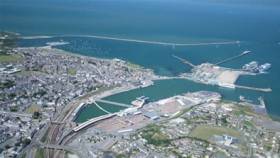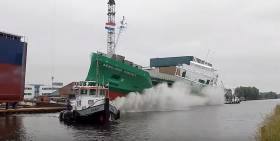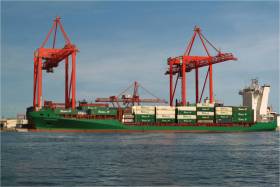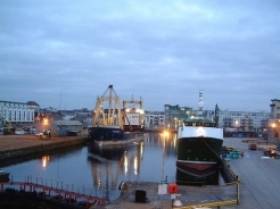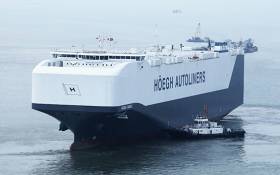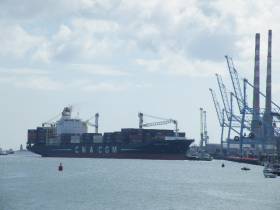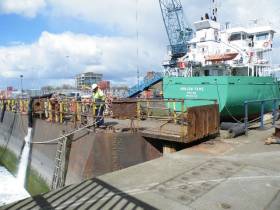Displaying items by tag: Ports and Shipping News
ESPO Drives Road Map to Cut Red Tape in Maritime Transport
#RedTapeRFD - Port authorities are one of the main stakeholders in the ongoing debate on implementation of the Reporting Formalities Directive (RFD).
The European Sea Port Organisation (ESPO) and its members have developed a roadmap defining some ambitious but realistic steps towards administrative simplification and trade facilitation.
ESPO believes that the recently launched REFIT evaluation of both the RFD and the VTMIS directives should be seen as the perfect opportunity to analyse the reasons why the RFD is not properly implemented and therefore does not achieve its aims. Making this analysis is clearly the first “to-do” of the roadmap.
Furthermore, ESPO identifies the following steps on the road to simplifying and streamlining reporting:
ESPO believes that a network of interconnected reporting systems sharing the same functional specifications would be the best solution at European level. This solution is the only way to ensure that electronic reporting is done through resilient and robust yet flexible systems that ensure the reliability of data.
Ships calling at EU ports should report the same data elements in each EU port in the same format (common data requirements) and only when justified by local circumstances, additional data.
ESPO calls the Commission to set up an industry expert working group to contribute achieving the above exercises.
To conclude, for European port authorities, accomplishing the internal market for maritime transport is a top priority. To realise this, the main focus should lay on administrative simplification and on removing customs obstacles to EU goods transported between EU ports.
Opening the ESPO Conference, ESPO Chairman Santiago Garcia-Mila said: “We believe that it is time to go beyond the “yes/no” discussion on a “European Maritime Single Window”, whatever it might mean. We believe that developing an ambitious but realistic roadmap, taking into account the realities of shipping and the existing EU and national legal requirements, will give the European ports and shipping industry a real window of opportunities!”
ESPO’s Secretary General, Isabelle Ryckbost says: “There is certainly room for simplification and achieving this is certainly on the wish list of European ports. But one cannot ignore that there will always be a need to report at port level to guarantee safe, secure and efficient operations. Moreover, for any system to work, it is crucial to work with reliable data that can be checked, if needed on their source. Finally, the resilience of any system should be seen as a top priority.”
#BREXITholyhead? - The United Kingdom's referendum on membership of the European Union is rapidly approaching, writes BBC News, but what does it mean for those places that find themselves at the centre of the debate - whether they want to be or not?
George Herd has been in the port town of Holyhead on Anglesey - and across the Irish Sea to the Republic of Ireland's capital, Dublin.
It is pub quiz question time: What links a truckers' rest and odds of 4/11 that the UK will vote to stay in the EU come the vote on June 23? That was the price on offer at the weekend from a well-known High Street bookies chain you can find in Holyhead on Anglesey.
The link? The founder and owner of the bookmakers also happens to be the co-owner of the Road King truck stop and cafe on the edge of the town. There, staff have just thrown a party to celebrate the venue's first birthday, and the £7m gamble to build it in the first place.
It was a gamble based on the simple premise: location, location, location. For much more on the BREXIT debate, click here.
#NewBuilds - A newbuild for an Irish shipping company was launched today from the same Dutch yard that delivered another vessel recently to Norwegian interests, writes Jehan Ashmore.
M.V. Arklow Cadet is not only the first of 10 in a new 'C' class series for Arklow Shipping Ltd but also the first to carry that name when she was launched this morning from Ferus Smit's Dutch yard. The 5,000 deadweight tons newbuild with yard no. 424 took to the waters at Westerbroek near Groningen.
In recent years the steady stream of ships built at this yard along with Royal Bodewes (which is located only a few kms away) have all been completed for ASL's division, Arklow Shipping Nederland B..V. On this occasion, Arklow Cadet a single hold (222.000cft) cargoship will be directly operated by Irish headquartered ASL and registered in the homeport of Arklow.
Arklow Cadet is under the 3000 gross tons limit and has a 1A ice-class notation. Propuslion is from a 1740 kW MaK engine with a single ducted propeller.
#FerryChiefProfits - Eamonn Rothwell, Irish Continental Group chief executive has made a €4.43 million profit on the exercise of share options in the company and their subsequent sale.
The Irish Times reports that Mr Rothwell bought one million shares at €1.067 under a share option scheme and sold them at €5.50, according to a stock market announcement yesterday.
The announcement showed that the company was informed of the transaction, which relates to just more than 0.5 per cent of the issued shares of ICG, on June 2nd.
It also revealed that Mr Rothwell now owns some 14.8 per cent of ICG stock. He holds 9.933 million shares personally, representing 5.3 per cent of the company stock.
A further 17.747 million shares are held by a company called Rokeby Investments Limited, which is wholly owned and controlled by Mr Rothwell. At current prices his shareholding in the company is worth more than €150 million.
For more from the newspaper click here
ICG this week took delivery of a newly acquired fast-ferry for $13.25m to Sealift LCC who in turn have chartered the craft to the US Navy's Military Sealift Command.
Port of Galway 'Disappointed' on Decision Delay
#DisappointedPort - Disappointment has been expressed by the Port of Galway at the delay in issuing a decision on the multi-million euro harbour extension, stating that it is difficult to plan for the future under such uncertainty.
The Galway Independent writes it has been almost two and a half years since the planning application to extend the port was submitted and the wait for a decision looks set to continue until the end of the year at least.
The €126 million port extension is a four-phase development that involves reclaiming 27 hectares of bay area, providing a new marina and berths which will see the biggest cruise liners in the world being able to dock at the harbour in the heart of the city.
The long awaited decision rests with An Bord Pleanala, who stated this week that they will be holding meetings with the National Parks and Wildlife Service and the applicant. These meetings have yet to be arranged.
Eamon Bradshaw, Chief Executive of the Port of Galway said, “The delay in issuing a formal decision is disappointing and whether the decision is for or against the port it is difficult for a commercial enterprise to deal with the uncertainty of the outcome of a planning application which planning was applied for in January 2014 or almost 2.5 years ago.”
He added that it is hoped that a formal decision will issue, at the latest, before the end of this year. “Should that decision be positive it is expected that the building of phase 1 would commence before the end of 2017 and complete by 2020,” Mr Bradshaw added.
At the weekend, Galway welcomed two cruise liners, the Astoria and L’Austral and passengers were tendered ashore from the ships.
For more the click the newspaper's report here.
#SGTpepperCalls – Sgt. Pepper was among several workboats that called to Dun Laoghaire Harbour last week to begin short to long term projects. Notably one project involves dismantling and removing the former Stena HSS berth, writes Jehan Ashmore.
Multicat, Sgt. Pepper, a name synonymously associated with the ‘Beatles’ eight-studio album ‘Sgt. Pepper’s Lonely Hearts Club Band’ was released in the summer of 1967. Only two years previously the first custom built car-ferry was launched onto a summer-only service on the route to Holyhead.
Sgt. Pepper had arrived into Dun Laoghaire last Thursday. The workboat operated by McMullan Marine Services, had sailed from Arklow via Dalkey Sound (see: ‘Maritime’ Dalkey of the Dalkey Community Council newsletter, May 2015) To read more and of the 'Maritime' series dating to July, 2011 click HERE from the downloadable back issues.
On arrival at the harbour, Sgt. Pepper begin working inspection of the RNLI moorings opposite the lifeboat stationhouse and souvenir shop located between the Royal St. George and the National Yacht Clubs.
The lifeboat station has two craft. They are the RNLB Anna Livia at moorings and the inshore craft RNLB Realt Na Mara that is housed in the old lifeboat station located at the foot of the East Pier.
Two days later, Sgt. Pepper was joined by a barge, SB-5016 that was towed by tug MTS Valour from Stranraer, Scotland (also a former Stena HSS ferryport) down the Irish Sea to Dun Laoghaire. The 10-week long project at this harbour is to remove the HSS ferry berth and related structures at St. Michaels Pier terminal. The works are expected to be completed in August.
Not surprisingly the coverage of the decommissioned Boeing 767 that was towed by barge from the Shannon Estuary to the Sligo coastal town of Enniscrone, centred on the aircraft. Afloat.ie however researched as to the identity of the barge and the tug involved.
It transpires the tug, MTS Statum belongs to the same company, Marine & Towage Service that operates the MTS Valour used for the Stena HSS related project in Dun Laoghaire. As for the barge used during the western seaboard passage that was the Wilcarry 1500 operated by Williams Shipping.
Returning to the eastern seaboard harbour, is where plans to restore the seasonal-only Dun Laoghaire-Holyhead closed by Stena Line in 2014 cannot proceed until the HSS berth is removed.
Operators were sought by Dun Laoghaire Harbour Company through an E-tender process that in early 2015 which drew seven potential operators.
As the ferry berth removal project is underway and throughout this summer, this has delayed in restoring a seasonal –service that was originally envisaged to begin at the earliest this year. If a successful operator is secured such a service will not be available until 2017. For more on this story click here.
Also at the harbour berthed next to the Danish barge SB-5016 at St. Michaels Pier terminal was Dublin Bay Cruise excursion boat St. Bridget.
Offshore of the ferry terminal was the largest vessel within the harbour, ILV Granuaile. The lighthouse and aids to navigation tender that is based in the harbour is also where the Commissioners of Irish Lights HQ and adjoining marine depot is located beside the marina.
Dublin Port 'Horizon' Changes With World's Largest PCTC
#WorldsLargest – The World's largest pure car and truck carrier (PCTC) vessel, Höegh Target, with a 14 deck capacity for 8,500 car equivalent units, made another call to Dublin Port today along with a giant cruiseship, writes Jehan Ashmore.
The arrival from Rotterdam of the 76,420 gross tonnes PCTC, is impressive given not just because of the sheer overall size of the leadship of six ‘Horizon’ class Chinese built newbuilds, but also the imposing square shaped upper superstructure at the bow. This compared to a circular conventional car-carrier design, is to maximise additional space to enable a total deck area equal to the size of 10 football fields or 71,400 sqm. Of the 14 decks, five are capable of been 'lifted'.
It is claimed by Norwegian operator, Höegh Autoliners, that the 12 meter width ramp could easily crowd 75 elephants! on the stern ramp which takes 375 tonnes of cargo weight. The final Horizon class that are Post Panamax vessels, is to be delivered this year and they are each estimated to emit 50 per cent less CO2 per car transported than a standard car carrier.
At 200m in length, Höegh Target is some 89m short of the ‘Grand’ class cruiseship, Caribbean Princess which too is docked in port.
As reported today, the 19 deck Caribbean Princess with more than 3,000 passenger capacity called from Cobh, Cork Harbour and is berthed at Ocean Pier. While on the other side of the pier is where Höegh Target docked within Alexandra Basin east.
Both vessels present a temporary high-rise environment on the port estate, where such large vessels are increasing in number to the port. This has led to the Dublin Port Company’s ABR project costing €277m, the largest single capital investment project in the port for 200 years.
The ABR is to permit very large ships with even deeper drafts following major dredging, to dock inside the port.
#TheTyrrells – Fifty years ago Arklow Shipping was formed, following the amalgamation in 1966 of three independent shipowning families from the east coast port in Co. Wicklow, writes Jehan Ashmore.
The families, Tyrrell, Kearon and the Hall’s all had origins directly in trading auxiliary sailing schooners from the banks of the River Avoca that flows through Arklow into the Irish Sea. The era of the days of sail trading were coming to a close during the 1950’s and ‘60’s as motorised coasters were increasingly taking over from the traditional schooners of the single-ship owners.
It was felt in certain quarters that such practises needed to be overhauled so to compete. This led to a co-operative which removed inefficiencies of the independent shipowners and instead by pooling resources to reduce costs.
The decline of the schooners by more efficient coasters led to the last Irish Sea schooner, De Wadden disposed. The vessel remains on display at the Merseyside Maritime Museum, Liverpool.
In the earliest formation to pool resources, the Arklow shipowners acquired a 12 year old German ship. The vessel had been taken as a war prize in 1945 by the British Admiralty and was sold in 1947 to trade with the Arklow families and renamed Tyrronall.
The coaster, Tyrronell derived its name from three letters chosen from the family surnames. The co-operative progressed when in 1966, Captains James Tyrrell, Michael Tyrrell and Victor Hall formed an umbrella company, Arklow Shipping under which together operated seven ships.
Under the following ship-owners: James Tyrrell Ltd contributed vessels (Darell, Valzell, Mariezell and Murell), Captain Michael Tyrrell (Avondale), Captain Richard Hall (River Avoca) and George Kearon Ltd (Reginald Kearon and Gloria). Of this initial fleet, all but two were managed by ASL.
It was not until 1970 that officially the company, Arklow Shipping Ltd was formed and over the next five decades, ASL have acquired numerous second-hand tonnage and ordered series of custom built vessels, notably from yards in the Netherlands, Spain and Korea.
The vessel naming nomenclature is now based on a nominated letter. i.e. the latest is 'V' for the recent newbuild series, in which Arklow Valiant was launched last month. This vessel is the third of 10 newbuild 5,100dwat tonnes general cargsoships completed by Dutch yard, Royal Bodewes.
Asides the newbuild, the fleet total is 45-strong and ships are either general dry-cargo traders or bulk-carriers. The smallest series in the fleet are the 'R' class, for example, Arklow Rose of 4,933dwt to the largest 'S' class bulkers, the Arklow Spray of 34,905dwt. Both vessels are Irish flagged and unlike the newbuilds will be Dutch flagged under Arklow Shipping Nederland B.V.
Across the ASL fleet, they transport a variety of cargoes among them in the bulk grain trades, steel rails, minerals, generals and containers.
The trading area is mostly north-western Europe though the bulk-carriers operate on international deep-sea trade routes.
#LargeContainership - One of the largest ever containerships in recent years docked in Dublin Port on the same day of the longest cruiseship to call to the capital, writes Jehan Ashmore.
Afloat.ie has in recent weeks been monitoring CMA CGM Shipping’s containership Nicolas Delmas, with a capacity of 2,207(TEU) twenty foot-long equivalent units, which on Tuesday had discharged and loaded at Peel Ports operated MTL terminal in Ringsend. See, Maersk Line’s new Seago Line route: UK-Ireland-Spain (Algeciras: hubport) for Med/ North African ports.
The call of Nicolas Delmas provided an ideal opportunity to visit Dublin Port where on the opposite side of the port, MSC Cruises giant cruiseship MSC Splendida at 333m long had berthed. This was was the second successive season to the capital by the 4,600 passenger capacity ship.
CMA-CGM's rotation of Nicolas Delmas is operated in a butterfly loop with the Windhoek, 1,577(TEU) on the FAS Irish Sea Feeder service that began in 2003. In fact, Windhoek is due to arrive this evening from Liverpool. Normally the rotation involves the following ports: Antwerp, Southampton, Liverpool, Dublin, Belfast, Greenock, Le Havre and then a return to Antwerp.
The Marsaille based CMA-CGM was formed in 1996 following a merger between Compagnie Maritime d'Affrètement (CMA) and Compagnie Générale Maritime (CGM). The latter partner, CGM had previously run a ‘liner’ side of the business with the famous classic liners 'France' and ‘Normandie’.
In the case of MSC Cruises, they are a parent company of Geneva based Mediterranean Shipping Company (MSC) that continues likewise of rivals CCM-CGM, in the operation of very large containerships fleets on global networks.
At the top of this massive global business is the Maersk Group, which operates the world’s largest container shipping company through subsidiary Maersk Line. Recently the operator launched a new direct Cuba-Cork-continental Europe service.
So it was interesting to witness the contrasting shipping sectors from Dublin's East-Link toll-lift bridge. Also on that day President Higgins in a ceremony unveiled a plaque as the bridge is now named the 'Tom Clarke Bridge'. The bascule bridge completed in 1984 is the final river-crossing between the Liffey and the main port area leading out to the sea.
Final Vessel to Dublin Dry-Dock is Aptly Irish-Flagged Cargoship
#FinalShip – The last ever vessel to use Dublin's dry-dock, cargoship Arklow Fame departed on Wednesday from the unique facility in the capital that officially closes today, writes Jehan Ashmore.
The shiprepairer, maintenance and engineering facility has since 2002 been run by Dublin Graving Docks Ltd under license of the Dublin Port Company. The port company has other plans for the site as part of the €277m ABR project, see report.
Today’s closure marks the end of a chapter in Irish maritime industry that is consigned to historical heritage as well as the loss of 26 jobs staff. The small yet skilled workforce have taken on tasks involving numerous vessels among them containerships, coasters, ro-ro freight ferries, supertrawlers, tugs and timber tallships.
It was fitting that the final vessel to use graving dock no.2 was the Irish flagged Arklow Shipping cargoship and given the Co. Wicklow based company were the firm's largest client.
The 90m Arklow Fame (4,950dwt) is one of the smaller cargoships in the ASL fleet to use the dry-dock as dry bulk-carriers such as the 136m Arklow Marsh (14,490dwt) have occupied the 220m long dockyard completed in 1957. In recent years the ‘M’ class have undergone conversion work at the country's largest dry dock in the capital to increase deadweight tonnage.
Asides routine work carried out on Arklow Fame, the leadship of 10 Spanish built ‘F’ class vessels built a decade ago, also saw work to install a new rudder stock. This involved a manufacturer in Europe to make the replacement part which was transported by truck to be installed at the Dublin facility.
The graving dock could take vessels up to 6.5m draft and had a 24.5m wide entrance accessed by a gate (caisson) see above photo. The watertight retaining structure would be floated in and out of position between pumping in or out water of the dry dock. It should be noted even when a ship was not in dry-dock, work took place at the yard's marine workshop and also off site where required.
Now that the dry dock is closed, ASL will be forced to go elsewhere, noting that Cork Dockyard has a graving dock, measuring 165.5m long and has a narrower entrance of 21.3m. Technically speaking, Arklow Fame with a beam of 14.5m could be accommodated at the country's now largest dry-dock.
So it remains the issues of cost, expertise and strategic location that will determine where shipowners take their business to a graving dock, be it at home or overseas.
In fact during Cork-Swansea Ferries operation and that of the main ferry that ran throughout those years was carried out by the Superferry, however her beam was too wide to use the Cork dry-dock. Instead, the Japanese ferry of more than 14,000 gross tonnes docked at the Dublin facility.
The frequency of ferries using Dublin dry dock however notably declined from around the mid-1990's as the size of newbuilds introduced on the Irish Sea have dramatically increased in tonnage.
This trend in larger ferries undergoing refit overhauls and repairs are mostly carried out in Belfast (Harland & Wolff), Birkenhead (Cammel Laird) and Falmouth (A&P Falmouth).



























